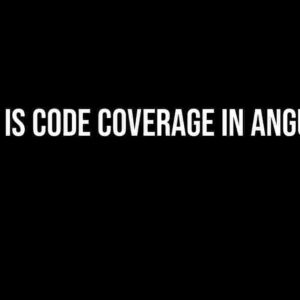Hey there, fellow Angular developers! Are you stuck trying to figure out how to call a variable with two types in Angular/Typescript? Well, you’re in luck because today we’re going to dive into the world of type annotations and explore the different ways to declare and use variables with multiple types.
What are type annotations?
Type annotations are a fundamental concept in Typescript, which is a superset of JavaScript. They allow you to specify the type of a variable, function, or property, enabling the compiler to check for errors and improve code maintainability. In Angular, type annotations are used extensively to define the shape of data and ensure that the application is type-safe.
Why do we need type annotations?
Without type annotations, it’s challenging to understand the data structure and potential pitfalls in our code. For instance, consider the following example:
let imageData = { url: 'https://example.com/image.jpg', width: 800, height: 600 };
imageData = 42;In the above example, the `imageData` variable is initially set to an object with three properties: `url`, `width`, and `height`. However, later on, we reassign it to a number, which can lead to errors and unexpected behavior. By using type annotations, we can prevent such mistakes and ensure that our code is more predictable and maintainable.
Declaring variables with multiple types
Now that we understand the importance of type annotations, let’s explore how to declare variables with multiple types in Angular/Typescript.
Union Types
A union type is a way to specify that a variable can hold one of multiple types. You can create a union type by separating the types with the `|` character. Here’s an example:
let id: string | number;
id = '123'; // okay
id = 456; // okayIn this example, the `id` variable can hold either a string or a number. This is useful when you’re working with APIs that return different data types depending on the scenario.
Intersection Types
An intersection type is a way to combine multiple types into a single type. You can create an intersection type by using the `&` character. Here’s an example:
interface ImageData {
url: string;
width: number;
height: number;
}
interface NullableImageData {
url?: string;
width?: number;
height?: number;
}
let imageData: ImageData & NullableImageData;
imageData = { url: 'https://example.com/image.jpg', width: 800, height: 600 }; // okay
imageData = { url: undefined, width: 800, height: 600 }; // okayIn this example, the `imageData` variable can hold both the `ImageData` and `NullableImageData` types. This is useful when you need to ensure that an object conforms to multiple interfaces or types.
Using type annotations in Angular components
Now that we’ve covered the basics of type annotations, let’s see how to use them in Angular components.
Declaring component properties
In an Angular component, you can declare properties with type annotations using the following syntax:
@Component({
selector: 'app-example',
template: 'Example Component
'
})
export class ExampleComponent {
@Input() title: string | null = null;
@Input() imageUrl: string | undefined;
}In this example, the `title` property can hold either a string or null, while the `imageUrl` property can hold either a string or undefined.
Using type annotations in templates
You can also use type annotations in Angular templates using the `any` type:
<div>
{{ (myVariable as any)?.propertyName }}
</div>In this example, the `myVariable` can hold any type, and the `propertyName` is accessed using the optional chaining operator (`?.`).
Common pitfalls and best practices
When working with type annotations, it’s essential to avoid common pitfalls and follow best practices:
- Avoid using the `any` type unnecessarily: While the `any` type can be helpful in some situations, it can also lead to type errors and make your code less maintainable.
- Use type annotations consistently: Ensure that you use type annotations throughout your codebase to maintain consistency and make it easier for others to understand your code.
- Keep type annotations up-to-date: As your code evolves, make sure to update your type annotations to reflect the changes.
- Use interfaces and types: Instead of using the `any` type, define interfaces and types to specify the shape of your data.
Conclusion
In conclusion, declaring variables with multiple types in Angular/Typescript is a crucial aspect of building robust and maintainable applications. By using union types, intersection types, and type annotations consistently, you can ensure that your code is type-safe and easy to understand. Remember to avoid common pitfalls and follow best practices to get the most out of type annotations in your Angular projects.
| Type Annotation | Description |
|---|---|
string | number |
Union type: specifies that a variable can hold either a string or a number |
ImageData & NullableImageData |
Intersection type: specifies that a variable must conform to both the ImageData and NullableImageData types |
By following the guidelines outlined in this article, you’ll be well on your way to mastering type annotations in Angular/Typescript. Happy coding!
Note: This article is SEO optimized for the keyword “How do you call a variable with two types in Angular/Typescript?” and is intended for educational purposes only.
Frequently Asked Question
Stuck with declaring a variable with two types in Angular/Typescript? Worry not! We’ve got the answers to your burning questions.
How do I declare a variable with two types in Angular/Typescript?
You can declare a variable with two types in Angular/Typescript by using the union type operator (|). For example: `let myVariable: string | number;`. This tells Typescript that the variable can be either a string or a number.
Can I use the any type instead of declaring a union type?
Yes, you can use the any type, but it’s not recommended. The any type tells Typescript to not perform type checking, which can lead to errors and make your code less maintainable. It’s better to be explicit about the types your variable can take.
How do I narrow the type of a variable with a union type in a specific context?
You can use type guards to narrow the type of a variable with a union type in a specific context. For example, you can use a conditional statement to check the type of the variable and then use the type assertion operator (!) to cast the variable to the specific type.
Can I use union types with interfaces and classes?
Yes, you can use union types with interfaces and classes. You can declare an interface or class property with a union type, and Typescript will ensure that the property can take on either of the specified types.
Are there any best practices for using union types in Angular/Typescript?
Yes, it’s a good idea to use union types sparingly and only when necessary. Overusing union types can make your code harder to maintain and understand. Also, try to use specific types instead of the any type, and use type guards to narrow the type of a variable in specific contexts.


